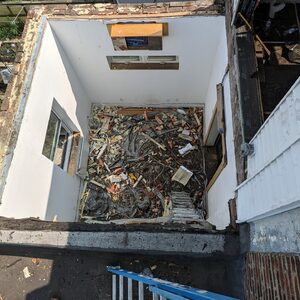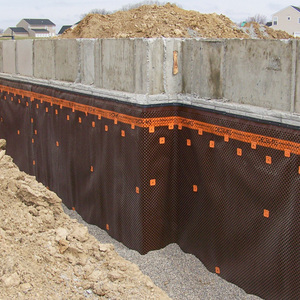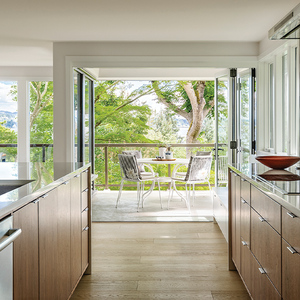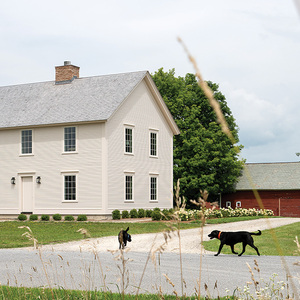Geothermal heat pump for radiant floors
It’s my first post, so please be kind!
I have used the search function and have found a few threads that address this, but I didn’t find any recent threads.
We are building a new house. It’s supposed to be tight tight super efficient. I like geothermal. I like radiant. It seems that using the geothermal heat pump as the heat source for the radiant floor heat is a no brainer. The first contractor I called today told me it couldn’t be done. The second said they do them sometimes.
We’re in southern Indiana, so we don’t have super cold winters, but even so, we’ll have the mandatory (wife’s dictate) gas fireplace, but I wonder if a backup heat source would really be necessary.
The second contractor also talked about the loops providing cooling, but that makes me nervous here where summer humidity is high as the rule. I prefer the air delivery of the cooling.
The 1st contractor made me paranoid, so I thought I should defer to the experts here.
Thanks!



















Replies
You're thinking right. It's easy enough to use the ground source heat pump (GSHP) to provide the heat for the RFH hydronic floor loops. A GSHP can also chill water and this works in the summer with hydronic-fed air handlers or fan coils for A/C.
The guy who said you can't do it might not be able to do it, but a qualified contractor could.
Edit: BTW, welcome to Breaktime. Hope you enjoy the experience. If this advice was helpful, send a note to the sysop and I get $10. [Not really, but it'll make the other guys wonder if they're getting ripped off...]
Edited 8/3/2006 7:40 pm ET by CloudHidden
I appreciate that, and SYSOP should pay you for that help!
Have a look at this company's products especially the TF series. Sounds like what you need. They do have dealers in the eastern US but I don't know if there are any in your area.
http://www.nordicghp.com/mg/about.htm
The owner is a very competent designer and has been in the GSHP field since 1977 or so. In the 1980's,I used to work on some high efficiency homes that had his systems installed .
Thank you!
it's the second contractor that's making me nervous.
when the chilled water running through your pex tubing starts causing moisture to condense on the outside of the tubing, it's going to start raining in the floor below.
do you really want cold floors beneath your feet anyway ?
and do you really want an HVAC contractor who has only installed one or two systems like the one you want ? you are looking for one of the more complex residential systems here.
who will service it once it is installed ?
you either need to find a different contractor or choose a different system.
carpenter in transition
You have my concerns listed right. The contractor has been the geothermal installer here for years. I got the impression that, in summer, water would be running through the pipes, but that it would go through a mixer so that it would not be cold, but cool, and that condensation would not be an issue. The primary cooling would be via air handler and ductwork.
As I am not an HVAC person, am I misunderstanding this, you think? Thanks for the input.
i am hoping you are misunderstanding. how will your system know the daily dew point temperature ?
you could have condensation in amounts that might not show up as leakage below but could cause long term rot and mold damage. this would just be a plain bad idea.
leave the cooling to the chiller coils with an air handler where the condensation is controlled by drains beneath the coils.
carpenter in transition
You are most wise!
The system doesn't need to know the dew point if the contractor is doing his job properly. You can restrict system water temperatures to provide some cooling as long as you are controlling humidity and if the air system is being used in that way, you have a controlled dew point in the home and a water temperature range restricted to a point where you won't condense.Designing a radiant cooling system is currently beyond my abilities as I am not a humidity/dew point expert. However they are workable in conjuction with air quality control/dehumidification, and I would tend to think that a contractor that knows it well enough to even suggest it is PROBABLY an expert. Most hacks wouldn't even think of it, much less suggest a workable system.http://www.healthyheating.com has lots of info on these combination type systems. This is a "Total Comfort System" as they discuss in some of their pages: radiant heating and cooling in conjunction with proper air and humidity control. Gives you complete control over all aspects of comfort. Totally sweet, in other words!!Contractor #1 is a hack though. Geo and radiant are excellent combinations, as long as your water temperature requires are kept low (under 120 max, I'm told by the geo guys). Choose your tubing installation method and finished floors wisely, and build a good envelope above all else, and you can quite easily do this.-------------------------------------
-=Northeast Radiant Technology=-
Radiant Design, Consultation, Parts Supply
http://www.NRTradiant.com
Edited 8/10/2006 9:53 am ET by NRTRob
>as long as your water temperature requires are kept low (under 120 max, I'm told by the geo guys)When we lowered our set point from 115 to 105 we found that the system ran a lot less and heated just as well. A GSHP definitely has a high temp limit different from a boiler.
I mean a geo system can service a radiant system up to a max water temp of 120. Lower is definitely better; doing a heat load calculation ahead of time can help select a radiant install method that will allow you to minimize your water temps for additional efficiency.-------------------------------------
-=Northeast Radiant Technology=-
Radiant Design, Consultation, Parts Supply
http://www.NRTradiant.com
I know. I was just backing up your comments with our experience.
You guys are awesome!
Rob,
my feeling here is that running chilled water through tubing buried in floors and walls is simply a really bad idea.
yes, it is possible that under the right conditions, this system could work.
why anyone would want cold floors is beyond me. common sense would dictate chilling the ceilings and allowing the cool air to fall.
i think that the risks completely outweigh the benefits. a system like this could lose its settings and overchill the water or have humidity levels run slightly higher for long periods of time in a residential setting without the homeowner ever knowing, possible resulting in some major damage due to condensation.
i know we rely more and more on technology today to always work, but, i see so many simple failures with clogged or frozen condensate drain lines, condensate drain pumps failing, etc. which cause tremendous localized damage that i couldn't see potentially expanding these types of problems across an entire house by chilling radiant tubing lines.
end of rant.
carpenter in transition
First, you're right that ceilings are better, and floors are limited as they get too cold for comfort quickly.However the arguements you make for control could easily apply to heating as well. Run 180 or 190 degree water through your floor system and all kind of bad things can ensue. Your tempering valve can stick and you can get hit with 140 degree water in your shower; so you design systems for failure.-------------------------------------
-=Northeast Radiant Technology=-
Radiant Design, Consultation, Parts Supply
http://www.NRTradiant.com
I'm not sure if the contractor is a hack, as I'm not sure what his exact objections were.If he's hesitant about the whole shebang...not just geo-to-RFH, but geo to run cool water through the RFH PEX to cool the house...then he's no hack.The geo-to-RFH is a fine way to heat.You don't want to cool the house via RFH tubing unless you have control over the house's humidity level, and even then that can be a crapshoot.For the cooling, re-read Cloud's Post #2, couple the cooled water from the geo to an air handler that will cool the house via cooled air through ducting.Just my thoughts, Mongo
Hey Mongo, long time...good to see your name...
Same to you Cloud. I haven't been here much lately, it's good to seem some familiar names are still around.Best, Mongo
I think if you have the technical know how to add radiant cooling to an already hydronic cooling system.. excellent. You're addressing more comfort factors than air alone will take care of. I won't pretend it's simple, that's why I don't design them yet. But radiant cooling is already being used to good effect in commercial applications and in europe and there is absolutely no reason why it can't be utilized here as well, except not many people have the overall skill set to handle the "total comfort system".-------------------------------------
-=Northeast Radiant Technology=-
Radiant Design, Consultation, Parts Supply
http://www.NRTradiant.com
Rob, I agree.
The brand that I am mot familiar with is Climate Master. The following folks are listed for IN:
Atlas Supply Company
702 North Tibbs Avenue
Indianapolis, IN 46222
Phone: 317-634-2500
Fax: 317 264 2624
Corken Steel Products Company
322 West Third Street
Covington, KY 41011
Phone: 859-815-1230
Fax: 859 291 8250
You may want to contact the closest one and have them provide you some input as well.
Thank you!
I am familiar with Corken Steel. Good people there.
Corken can give you a couple of HVAC contractors names to call. Top of their list Is Solar Design followed by a few others.
Dave (last name escapes me right now) ownes the company and is a terrific guy. He will do your load calcs and design. I don't know how far into southern IN he goes, but he is one of the best in this area (I'm in Louisville). He has designed and installed the combination you are looking at.
I have seen their work. It is better than any residential contractor I have seen in the past 25 years. IMO he is worth the slightly higher price that they charge.
I'll get you a contact name and number if you want.
Dave